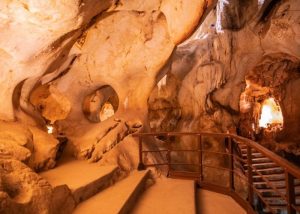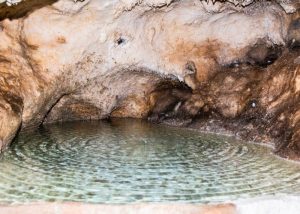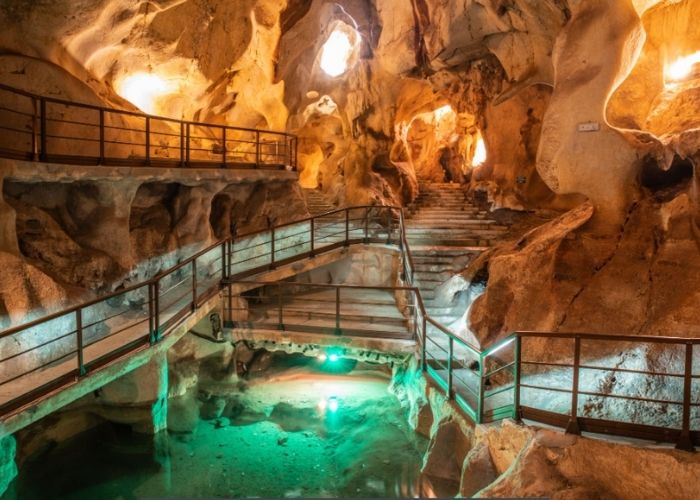MALAGA – The municipality of Rincón de la Victoria (Málaga) registered this summer more visitors than ever to the unique sight that InSpain.news visited in this coastal town twelve kilometres east of the city of Málaga. The Cueva del Tesoro – the Cave of the Treasure – is truly a treasure for humanity and provides us with a fascinating afternoon.
This August, 17,259 visitors admired the treasures hidden deep under the surface, marking a 25% increase compared to August of last year, which was previously the best month ever. The Cueva del Tesoro is the only sea-shaped cave in Europe that can be visited. Of these, there are only two others and they are located in Mexico and China. Why is something like this not included in all lists and overviews for tourists who visit this part of Málaga? The fact that you reach the cave entrance after crossing somewhat faded urbanisation on top of a hill also does not emphasise the exceptionalism of this attraction.
We save our visit for a rainy day, as not much is to be done on days like this. Therefore, it is also a good idea to seek refreshment deep underground in the hot summer months. Furthermore, the average temperature is always 18 degrees Celsius.
Free entry on Mondays
On this day with so few others curious that they can be counted on one hand, the reception area seems excessively large. However, the entrance fee, on the contrary, is minimal. As such, everyone can enter for free on Mondays. We pay only €4.65 and receive an audio guide with explanations about each area in Spanish or English. We then descend into the earth via long stairs.
The reception is set up as an information centre and some archaeological finds can be admired. And on the way down we read more about the origin and background of the cave. Below the enthusiastic security guard speaks to us. She tells us so much that we can put our audio guide down. It is clear that the goddess Noctiluca and ‘El Suizo’ fascinate her the most and now us too. Curious we walk on to the halls of the same name.
Cueva del Tesoro
The Cueva del Tesoro is more than two and a half kilometres long. And almost 600 metres of this is accessible to the public. There are several halls in that part, including one with underground freshwater lakes. Originally the cave was called Cueva del Higuerón. A fig tree once grew in front of the entrance. Later it became the Cave of the Swiss (La Cueva del Suizo) and later the cave got its current name.

The walls of the underground chambers are mainly made of white limestone. As a result, they were formed when this part of Spain was still a seabed. The ever-moving water, the pressure of the sea, and the crashing waves for millions of years formed corridors, halls, and caverns that eventually rose above sea level after the collision of tectonic plates. From that moment, the cave changed shape through ‘normal’ geological processes, and stalagmites, stalactites, and other erratic shapes also formed.
Paintings on the walls
Prehistoric paintings found on the walls deep in the cave show that the underground spaces had a cultural function for the inhabitants of that time between 30,000 and 5,000 years ago. The paintings are in red and yellow. Furthermore, notes from more recent underground explorers were also found. However, unfortunately, the paintings are closed to the public to protect them from decay.
Related post: New cave shows possible signs of human presence
The Cueva del Tesoro is no ordinary cave, as we can see from a large amount of smooth, rounded, and shiny rock walls due to the high moisture content. The wondrous shapes contain crevices, caverns, and dark niches that are beautifully highlighted by the subtle yellow-orange lighting. Everywhere mysterious corridors that we are not allowed to arouse our curiosity.
Al-Andalus
In addition to the paintings, other archaeological finds also pointed to human presence in the cave from prehistoric times to the time of Al-Andalus. These include flint-cut knives, arrowheads and harpoons made of bone, bone remains, and complete skulls, ceramics, bracelets, a candlestick, and coins that indicate Phoenicians, Romans, and Arabs. Most of the artifacts are now in the National Archaeological Museum in Madrid. Some replicas can be admired in Rincón itself.
The Treasure and the Swiss
We walk into the Sala del Suizo. The Hall of the Swiss. For centuries there has been a legend that this cave is home to a treasure. It is said to have been left there by five Arab kings in the twelfth century to protect their valuables against the advancing armies of the Catholic Monarchs. So many ventured into the depths of this patch of earth in hopes of being the finder of the treasure.
 The most famous treasure hunter is the Swiss adventurer Antonio de la Nari, ‘El Suizo’. He searched for the treasure for nearly twenty years in the mid-nineteenth century. During that search, he lived in the cave that he left only to buy food. By working with dynamite, he facilitated his search and opened several corridors and a well. Unfortunately, in 1847, he also blew himself up. His ghost, with a long white beard and only visible from the waist down, is said to still haunt the cave according to the testimony of several visitors and collaborators.
The most famous treasure hunter is the Swiss adventurer Antonio de la Nari, ‘El Suizo’. He searched for the treasure for nearly twenty years in the mid-nineteenth century. During that search, he lived in the cave that he left only to buy food. By working with dynamite, he facilitated his search and opened several corridors and a well. Unfortunately, in 1847, he also blew himself up. His ghost, with a long white beard and only visible from the waist down, is said to still haunt the cave according to the testimony of several visitors and collaborators.
The goddess of the night
However, the spirit of the Swiss is not the only special phenomenon in the Cueva del Tesoro. In 1915 the pharmaceutical company Enrique Laza Herrera bought the land including the cave underneath to cultivate medicinal plants. He left it all to his son Manuel Laza Palacio. He became so fascinated by the cave and explored it for more than four decades until his death in 1988. Those efforts proved fruitful, for he discovered the sanctuary of the goddess of the moon, night, fertility, and death, Noctiluca.
Palacio wrote: ‘I was lucky enough to find this prehistoric sanctuary in which lies the germ of the city of Malaka (…) After the painful excavation in the hidden chambers of the Swiss at the bottom of the cave, I discovered the strange limestone figure resembling the figure of a woman wrapped in a cloak’. In front of this figure, in which a round hole indicates the face, lies a stone bowl in which Palacios found ashes. He had these examined and turned out to be bone
There was also an altar in the shape of a crescent moon at the foot of the statue of Noctiluca. Palacios concluded that Iberians and later the Phoenicians sacrificed at this altar. He also found a candlestick from the time of Al-Andalus and five gold coins. That find added fuel to the legend of the treasure and gave the cave its current name.
Other rooms
In addition to the halls mentioned, there is the Sala de Marco Craso. This Roman would have settled in the year 86 BC. have hidden in the Cueva del Tesoro on the run from general Marius and politician Cinna. This would be apparent from the work of Plutarch, an important Greek historian and philosopher who lived from about AD 46 to at least 120 AD. and was recorded in 1789 by Cecilio García de la Leña in ‘Conversaciones Históricas Malagueñas’.

In the Sala de la Virgen, Palacios found the Arabic candlestick. This space owes its name to the fact that the discovery was made on the day of the Virgen del Pilar on October 12. The Sala del Águila is so named because of a rock that has the shape of an eagle in flight.
Also read: The spectacular Antequera Dolmens site
While walking to the Sala del Volcán (hall of the volcano), which lies at a great depth, something strange happens: the temperature suddenly rises sharply, hence the name. Finally, there is the Sala de Los Lagos, where the greatest filtration of freshwater has taken place and most of the stalagmites and stalactites can be admired, in addition to three natural lakes.
How to get there
The caves are located 10 kilometres east of Málaga and can be reached via the A-7 where you take exit 252 and head south into Carretera Benagalbón. The entrance is on Avenida de Picasso nº 21 (Cantal Alto). There is a large parking lot. The cave is open until September 30 from 10.00 am to 1.00 pm and 3.00 pm to 5.00 pm and in winter (October 1 to May 30) from 10.30 am to 1.00 pm and 4.30 pm to 7.00 pm. Price for adults is € 4,65, kids (4-14 years) € 4,75.


